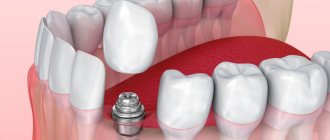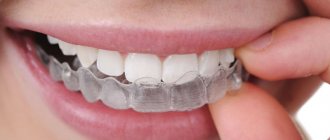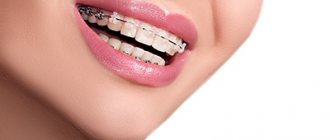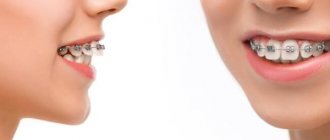A gold crown is a kind of “cover” that is placed on a seriously damaged tooth that is unable to perform its functions. This “cap” helps a person chew food comfortably again without experiencing discomfort or pain. The prosthesis can be made either for one damaged tooth or in the form of a bridge that fills the empty space in place of several missing teeth.
Crowns are made from high-grade gold - 900 gold standard. It is this high-quality metal that is best suited for making a dental “cap”, because it does not oxidize from contact with moisture and is hypoallergenic. At the same time, gold is a fairly durable material that can withstand heavy loads when chewing hard food.
What it is
Gold crowns are “caps” made of dental gold 900 and placed on the teeth to restore chewing functions. They can be used to correct the defect of a single tooth, or to replace several missing teeth using a metal bridge.
Gold has been used in dentistry for centuries and this is not an accident. This metal does not cause negative reactions from the body, is not subject to oxidation under the influence of saliva, and does not cause allergic reactions. At the same time, it is quite durable and can withstand even significant chewing loads.
Use of gold in dentistry
There are two ways to make such crowns: stamped and cast. For stamped ones, special blanks are made. Cast products are cast from gold using wax casts. They do not require any adjustment during installation because they already have a certain size. Cast products are more expensive than stamped ones, but in this case the tooth has to be ground much harder.
Dental crowns from 850 to 900 gold are used. In order for the prosthesis to be stronger, it is made not from pure gold, but with the addition of silver and copper.
Advantages and disadvantages
Advantages of false teeth made of gold:
- High biocompatibility with tissues of the human body. Gold does not cause the development of allergic reactions, is not toxic and does not provoke discoloration of the gums and enamel of adjacent teeth.
- Under the influence of oxidizing agents, gold crowns do not corrode and do not oxidize in the mouth. Therefore, they do not change the taste of saliva and cannot cause the development of an unpleasant odor.
- The sufficient softness of the metal makes it possible to produce crowns that exactly match the tooth being prosthetized and fit tightly to the supporting dense tissues.
- Gold has a high strength coefficient, does not chip and can withstand constant intense loads, so it is ideal for prosthetics of chewing teeth.
- Long service life. With proper prosthetics and proper care, gold crowns can last up to 15 years or more.
- Gold teeth have the same abrasion coefficient as natural enamel, so such dentures do not cause damage to the hard tissues of antagonist teeth.
- The anti-inflammatory effect is a reliable prevention of caries of supporting teeth under crowns.
But, despite the large number of advantages, several disadvantages of gold teeth can be noted:
- The low aesthetics of gold structures makes them undesirable for dental prosthetics in the visible smile area.
- The need to prepare a tooth for a crown is due to the fact that it is necessary to remove part of the hard dental tissues to ensure a tight fit of the metal structure. In addition, the gold prosthesis has a certain thickness that must be turned.
- The cost of gold false teeth is quite high.
Appearance of dental crowns: photos of patients.
The initial situation is that extensive fillings on the chewing teeth have become untenable, darkened, and secondary caries has developed underneath them.
After installing ceramic crowns on a zirconium dioxide frame.
The initial situation is that the frame of the metal-ceramic crown on the front tooth has become exposed, and the border of the old restoration with filling material on the adjacent tooth has become visible.
After installing all-ceramic crowns on both front teeth.
Manufacturing
Gold metal crowns are of the solid-cast type and are manufactured in several stages:
- After preparing the oral cavity and grinding the teeth, impressions are made of the dentition of the upper and lower jaw.
- In the laboratory, based on impressions, plaster models are made, which serve as a standard and an exact copy of the patient’s dental characteristics for the technician.
- In accordance with the plaster model, wax copies of future crowns are made, which are sent to the dentist’s office for fitting and adjustment.
- If the patient and doctor are satisfied with everything in the wax model, then the final gold crowns are cast on its basis, which are then ground and polished.
»
What are the best dental crowns?
It is reasonable to make a decision about the choice only after consulting a doctor. Spartamed dentists will tell you about all the prosthetic options available today in our clinic.
If we talk about the advantages of materials for prosthetics, then the crown should be given to crowns made of metal-free ceramics: both all-ceramic and on a zirconium dioxide frame. They look great because they reproduce the color, texture and transparency of real tooth enamel without any errors, and their safety margin is quite enough to withstand the chewing load on a par with natural teeth.
Installation
The process of installing gold crusts takes several visits to the dentist’s office:
- At the first visit to the doctor’s office, the patient’s oral health is examined, caries is treated and, if necessary, old fillings are replaced. The dentist grinds the tooth on which the gold structure will be installed. In this case, dense dental tissues are ground down within 1 mm, when for metal-ceramic dentures this figure reaches 2 mm.
- After making impressions, the doctor makes a temporary overlay plastic prosthesis on site, which protects the tissues of the supporting tooth and performs an aesthetic function.
- At the second visit, the dentist tries on a wax model of the prosthesis for the patient, adjusting it and correcting any identified deficiencies.
- During the patient's third visit to the doctor, the final gold crown is tried on and fixed with temporary cement for up to three months. This is necessary in order to finally verify the correctness of manufacture and the comfort of the design.
- After 3 months, the crown is removed, cleaned of cement residues, and its effect on soft tissue is checked. If there are no contraindications, the gold prosthesis is fixed to permanent composite materials.
You can get crowns on your teeth in Moscow at a cost-effective rate at Dantistoff Scientific Dentistry. Orthopedic dentists, candidates of sciences of the highest category. Sign up.
Chieffa 08 Sep 2008
With enviable regularity, doctors hear the same question from patients: “Why, after installing crowns/inlays, does my head steadily pull down?” Or: “Which crowns are heavier: zirconium, metal-ceramic, cast, stamped? Because my teeth/gums are weak....”
The first five times doctors find it funny, then it’s no longer funny, and then they begin to think, “What if it’s really...?”
So, so that patients do not worry in vain, it will be useful for them to know: The average weight of one crown is 1.5 – 3 grams. The weight of the intra-root tab is 1.2 grams.
When chewing, the tooth experiences a load of 30 to 90 kg. So it doesn’t matter to the tooth whether a crown weighing 2 grams or 4 grams is on it!
For those who still feel that the weight acquired after prosthetics is pulling their head down, we can recommend having a haircut like this to move the center of gravity of the skull to its original place (longer at the back, shorter at the front).
Life time
Gold crowns are considered one of the most durable dentures. If such structures are made correctly and are ideally suited for a person, as well as with proper care for them, their service life on average reaches 15 years. But there are often cases when such crowns do not need to be replaced or repaired even after 20-25 years.
Gold crowns are reliable and durable structures, but only a dentist can correctly assess the possibility of installing them for each patient. When choosing one or another method of prosthetics, you need to listen to the opinion of a specialist.
Don't let yourself be deceived by a scammer
The most pressing topic, which all experts mostly refuse to talk about, is fraud on the part of jewelers. Of course, the lion's share of goldsmiths work honestly. But only a few of them speak publicly on this issue and give clients advice on how to protect themselves from dishonest colleagues or outright scammers.
When contacting unverified authors, people may encounter these types of scams.
- Substitution of precious stones.
- Dilution of gold composition.
- Conscious increase in the consumption of precious metals in the manufacture of jewelry.
Few people turn to private jewelers to melt down their gold, and therefore word of mouth does not work well in these cases. Not each of us has such acquaintances whose opinion we could safely rely on. Therefore, you will have to contact jewelers at your own peril and risk, testing their honesty experimentally.
To insure yourself against fraud, you need to be extremely careful and require various additional checks. For example, if you brought a gold item to a jeweler inlaid with stones that you want to see in a new piece of jewelry, ask that you record all their characteristics. Carefully inspect the stone yourself and note that there are no chips or scratches on it. If the pebbles are small and there are a lot of them, carefully count the number. When receiving a new gold item, double-check everything carefully.
Crooked or "double" Yaeba teeth
The fashion for crooked front teeth originated in Japan. There, patients attack dental clinics in order to make themselves sharp, elongated and protruding fangs almost to the second row. According to Japanese ideas about beauty, this gives the image youth, attractiveness and magnetism, making it different from the monotonous standards of beauty adopted in America and Europe.
In Japan, people with malocclusions have been rejoicing over this state of affairs for the past few years, because they are so similar to the favorite anime characters and teenage schoolchildren cultivated in this country. And those who have straight teeth rush to correct the situation by going to the dentist and investing about $400 in a “crooked” smile. In some dentistry, for this purpose, doctors decide to sharpen teeth or, conversely, build them up; in others, they offer patients to make special onlays.
The fashion for crooked front teeth originated in Japan.
Notice
: Undefined variable: post_id in
/home/c/ch75405/public_html/wp-content/themes/UltraSmile/single-item.php
on line
45 Notice
: Undefined variable: full in
/home/c/ch75405/public_html/wp-content /themes/UltraSmile/single-item.php
on line
46
Rate this article:
( 3 ratings, average: 5.00 out of 5)
crown
- Altynbaeva A.P., Samarina V.S. Veneers and Lumineers: the key to a beautiful smile. // Bulletin of medical Internet conferences. – 2016.
- Eliseeva E. P. About the special language of jewelry // Bulletin of the Omsk State Pedagogical University. Humanities studies. – 2022.
Expert “Interfering with the natural beauty of a smile in order to change the image, rather than restore, protect, cure and maintain health, is not the best idea. But if, in the opinion of a person, this cannot be avoided, it is necessary to contact professional dentists to carry out such work and do not forget to carefully care for the oral cavity after installing jewelry, undergo professional hygiene and preventive examinations. The presence of additional artificial elements in the mouth and insufficient hygiene increases the risk of developing caries and other inflammatory diseases.” Orthopedist Andrey Rastislavovich Chernov
Consulting specialist
Chernov Andrey Rastislavovich
Doctor rating: 9 out of 10 (1) Specialization: Orthopedist Experience: 11 years
Rehabilitation period
If the work is performed at the proper level, there will be no need for special adaptation to gold microprostheses, since from the point of view of sensations they do not stand out in the dentition and are almost immediately able to withstand a full chewing load.
You will have to refrain from eating and drinking for several hours after installation. This need is determined by the materials used to secure the prosthesis.
In order to increase the service life and comfortable adaptation to the crown, it is not recommended to eat solid food.
Possible unpleasant consequences of installing crowns:
- Increased tooth sensitivity . Failure to remove the nerve under the treated tooth in advance increases the risk of a reaction to cold, hot, sour, etc. It is necessary for the dentist to prescribe a special toothpaste.
- A crown that is too high can cause pain when chewing . In such a situation, a second visit to the dentist will be required.
- When performing parafunction of the masticatory muscles on a patient, you will need to use a night guard.
- Washing out the cement on which the microprosthesis was fixed . This increases the risk of crown mobility, or its complete destruction, and infections penetrating under the structure. A second visit to a specialist is required to secure the crown more firmly.
Twinkles
This is a more advanced and expensive version of skyes, made primarily of precious metals (usually white and yellow gold) and inlaid with precious stones (sapphires, rubies, emeralds, diamonds).
Twinkles are made of precious metals and stones
Twinkles or twinkles2 (in some literature) are fixed to the teeth in a different way than skyes. First, a small hole is drilled in hard tissues, where the decoration is placed. If it becomes necessary to remove the stone later, the artificially created cavity in the tooth will have to be masked with a composite.
Hygiene measures
No special conditions are required to maintain operation. Cleaning is carried out with a toothbrush with soft bristles, sweeping movements in the direction from the gums to the free edge. Plaque on the surface of the alloy practically does not accumulate due to the smoothness of the coating.
You should use floss or dental floss to remove food debris from the interdental spaces. For convenience, you can purchase an irrigator - a device that cleans with a thin stream of water.











